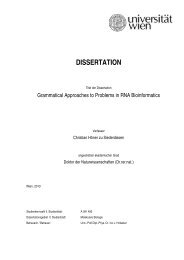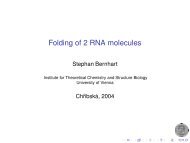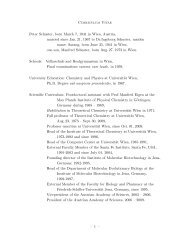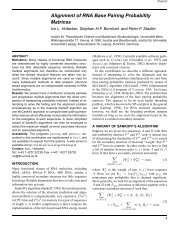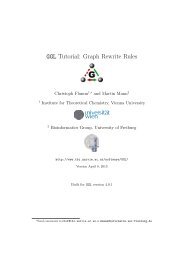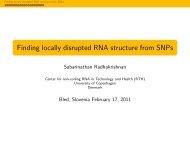A Toy Model of Chemical Reaction Networks - TBI - Universität Wien
A Toy Model of Chemical Reaction Networks - TBI - Universität Wien
A Toy Model of Chemical Reaction Networks - TBI - Universität Wien
You also want an ePaper? Increase the reach of your titles
YUMPU automatically turns print PDFs into web optimized ePapers that Google loves.
68 BIBLIOGRAPHY<br />
[38] I. Fleming. Frontier Orbitals and Organic <strong>Chemical</strong> <strong>Reaction</strong>s. Wiley:<br />
New York, 1976.<br />
[39] E. Fontain and K. Reitsam. The generation <strong>of</strong> reaction networks with<br />
rain. Part 1. The reaction generator. J. Chem. Inf. Comput. Sci.,<br />
31:96–100, 1991.<br />
[40] W. Fontana. Algorithmic chemistry. In C. G. Langton, C. Taylor, J. D.<br />
Farmer, and S. Rasmussen, editors, Proc. Workshop on Artificial Life<br />
(ALIFE ’90), volume 5 <strong>of</strong> Santa Fe Institute Studies in the Sciences<br />
<strong>of</strong> Complexity, pages 159–210, Redwood City, CA, USA, Feb. 1992.<br />
Addison-Wesley.<br />
[41] W. Fontana and L. W. Buss ’The arrival <strong>of</strong> the fittest’: Toward a<br />
theory <strong>of</strong> biological organization. Bull. Math. Biol., 56:1–64, 1994.<br />
[42] W. Fontana and L. W. Buss The barrier <strong>of</strong> objects: From dynamical<br />
systems to bounded organization. In J. Casti and A. Karlqvist,<br />
editors, Boundaries and Barriers, pages 56–116, Redwood City, MA,<br />
1996. Addison-Wesley.<br />
[43] M. Frenklach. <strong>Model</strong>ing <strong>of</strong> large reaction systems. In J. Warnatz and<br />
W. Jäger, editors, Complex chemical reaction systems, mathematical<br />
modelling and simulation, volume 47 <strong>of</strong> Springer Series in <strong>Chemical</strong><br />
Physics, pages 2–16. Springer-Verlag, Berlin, 1987.<br />
[44] R. Fugmann. In Proceedings <strong>of</strong> the IUPAC Congress 1959, pages 331–<br />
341, 1959.<br />
[45] S. Fujita. Description <strong>of</strong> organic reactions based on imaginary transition<br />
structures. 1. Introduction <strong>of</strong> new concepts. J. Chem. Inf. Comput.<br />
Sci., 26:205–212, 1986.<br />
[46] K. Fukui, T. Yonezawa, and H. Shingu. A molecular orbital theory<br />
<strong>of</strong> reactivity in aromatic hydrocarbons. J. Chem. Phys., 20:722–725,<br />
1952.<br />
[47] N. W. Gabel and C. Ponnamperuma. <strong>Model</strong> for origin <strong>of</strong> monosaccharides.<br />
Nature, 216:452–455, 1967.<br />
[48] C. W. Gardiner. Handbook <strong>of</strong> Stochastic Methods. Springer, Berlin,<br />
1985.<br />
[49] M. R. Garey and D. S. Johnson. Computers and Intractability. W. H.<br />
Freeman and Co., New York, 1979.







